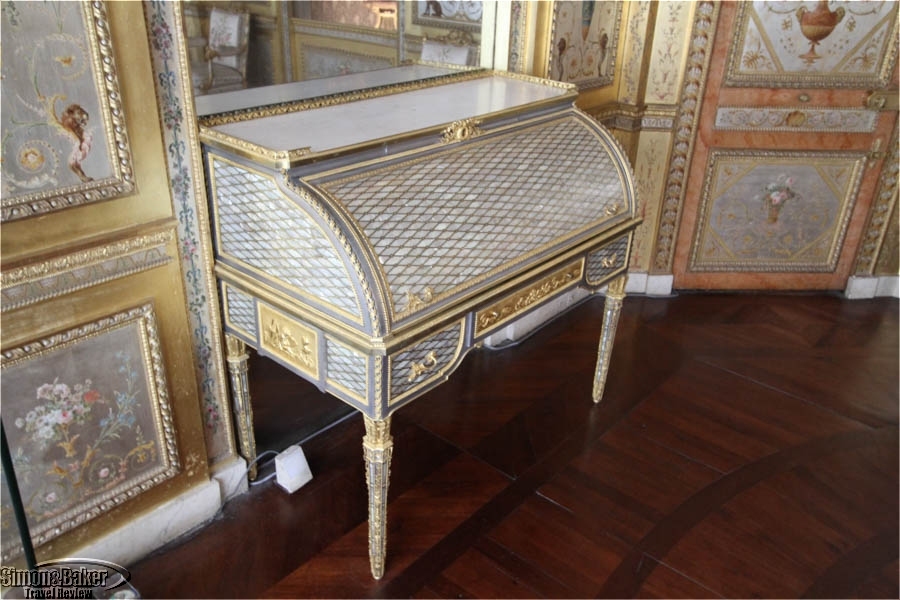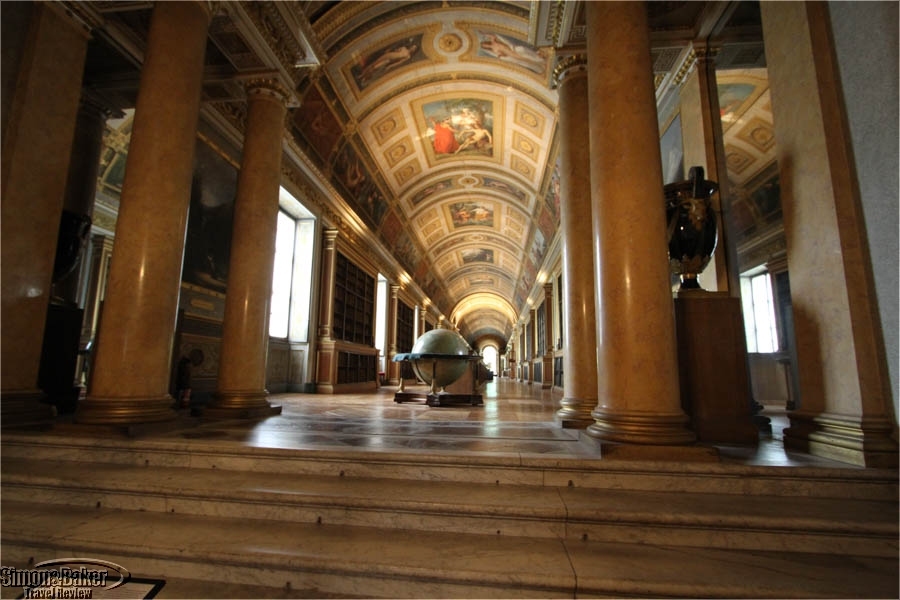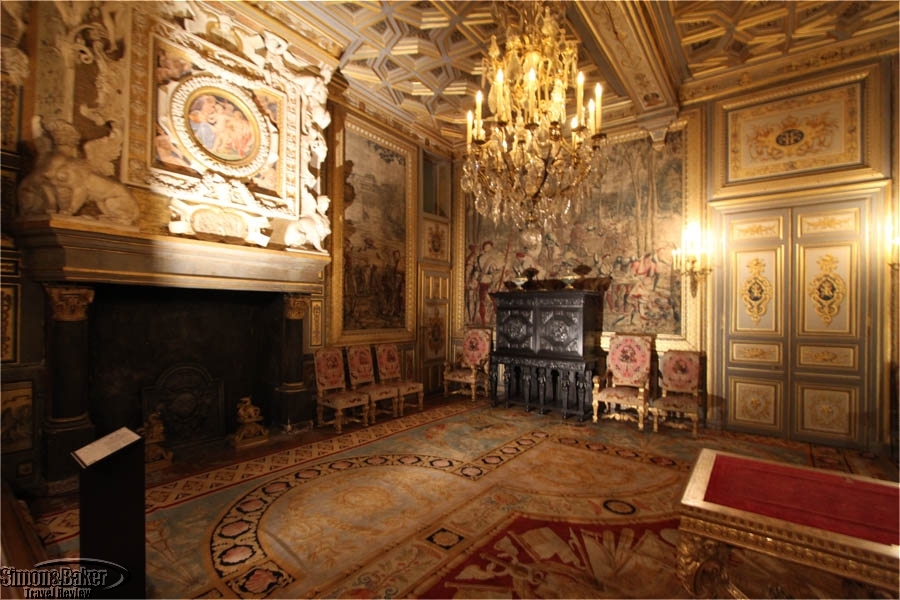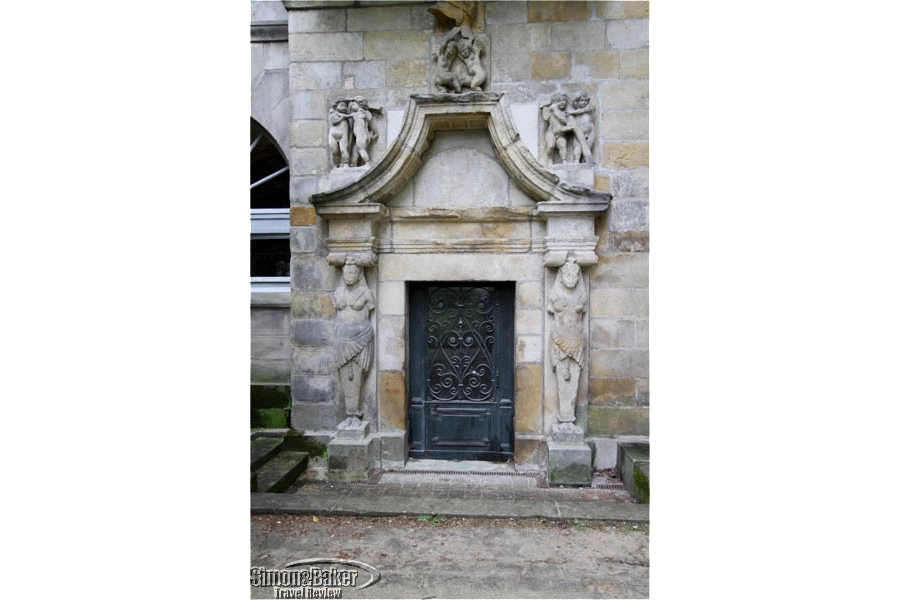

































That was because it had a fraction of the visitors as some of the other well known castles, museums and attractions in or near Paris. For example, where Fontainebleau had about 500,000 visitors a year and a staff of 130 Versailles, a famous former royal residence near Paris, had 7.5 million visitors and ten times the staff. We had nearly equal rainy conditions during our visit to both castles, yet our experience in Fontainebleau was by far more sedate and pleasant than the one to Versailles. On the day of our visit, while there was a large group of rather boisterous children it was otherwise significantly less crowded and easier to visit than Versailles had been only a few days earlier.
Fontainebleau had the unmistakable touch of multiple successive owners who each had added to or torn down from the structure according to their whims, budget and needs while they were residents there, molding the castle to their personality and circumstances. During its history all the French sovereigns lived at the castle beginning in the XII century.
Fontainebleau is the only royal and imperial castle to have been continuously inhabited for seven centuries. Our visit provided us a unique view of French history, French art history and architecture. It was especially illuminating in the company of our well informed and enthusiastic English speaking guide as part of a private morning tour and well worth a return visit.
Children Yes, of all ages.
Description We toured the castle in the company of Véronique Villalba, a licensed guide with patience and enthusiasm who brought the attraction to life during our brief time together and made us keen to return. About 40 percent of the structure was open to the public and 30 percent of that was open to unescorted (without a guide) visitors. From among the salient features we saw the Royal apartments, Renaissance Rooms, one of Marie Antoinette’s Boudoirs, Francis I Gallery, Galerie de Diane, Chapel of the Trinity, Chapelle basse Saint-Saturnin (only the upper level). We saw many of the masterpieces: The Duke of Orléans Commemorative Wedding Cabinet, Charlemagne in the Guise of Henry IV (in the Chapelle de la Trinité), The Royal Elephant (in the Galerie François Ier), Alexander Taming Bucephalus (in the Galerie François Ier), Odyssey Cabinet (in the Ancienne Chambre de la Reine), Beneman Commode (in la Nouvelle Chambre de la Reine), Marie Antoinette’s Bed, Napoleon’s Throne. Outside we walked through or caught a glimpse of its gardens and courtyards (sometimes from a distance): Cour Ovale, Cour de la Fontaine Cour d’Honneur, Cour des Offices, Grand Parterre (created by André Le Nôtre and Louis Le Vau and said to be Louis XIV’s greatest architectural achievement at Fontainebleau), Jardin Anglais, Jardin de Diane, Grotte des Pins, Pavillion de l’Étang, and Park.
Established In 1927, the castle opened as an attraction to the public.
Handicapped Access Wheelchairs were available.
Location In the heart of the town of the same name in the Seine-et-Marne Department (www.turisme77.co.uk and www.paris-whatelse.com) near Paris, France
Owned-Managed Ministere de la Culture et de la Communication (government of France)
Size The 46,500 square meter museum had 1,536 rooms, 130 acres of gardens and 130 employees.
Transportation From Paris we took a train to a nearby town and from there we made our way by car to Fontainebleau.
Reviewers
Article by Elena del Valle
Photos by Gary Cox
Would You Visit This Attraction Again Yes
Contact Information
- Address:
- Fontainebleau Castle
- Château de Fontainebleau
- Place du Général de Gaulle
- 77300 Fontainebleau
- France
- Phone:
- +33 1 60 71 50 60/70
- Website:
- Email:
First of all thank you Elena and Gary for the nice comments and beautiful pictures about this fantastic château.You obviously got contaminated with my “enthusiasm” about the place! It makes me happy!
Let me allow myself to bring a little correction. The château is not 7 but over 8 hundred years old. The first written document mentioning the place dates from 1137. However, during the 100 year long war we had against the British people, our kings settled down in the Loire Valley and stopped coming to Fontainebleau. Which means that yes, we can talk about 700 years of “royal visits” in a 800 year old château. Et voilà!
Definitely, I found your enthusiasm contagious and enjoying the visit the more for it. Thanks again! And, thanks for your correction.
Elena